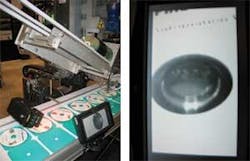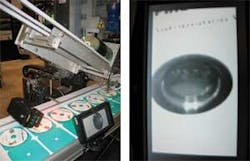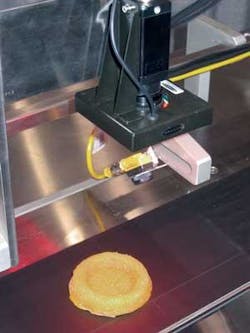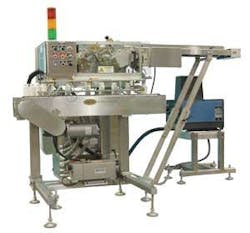Vision sensors find automation applications
Andrew Wilson, Editor, [email protected]
September’s PackExpo, held in Las Vegas, NV, USA, gave attendees insight into the latest product-insertion, packaging, and inspection equipment. With very large booths demonstrating equipment to process pharmaceuticals, food, beverages, and consumer products, vendors also showed how the latest vision sensors are being used to ensure the quality of the finished product.
Banner Engineering (Minneapolis, MN, USA; www.bannerengineering.com) showed how its customers are using smart vision sensors in applications that include inspection of compact disks (CDs), checking the quality of baked goods, and inspecting pharmaceutical bottles for correct outsert placement. In these applications, the functions being performed by Banner’s low-cost smart sensors were relatively simple vision tasks such as gray-scale analysis, blob inspection, and template matching. Despite this, the added value they provide to suppliers of packaging machines allows quality assurance to be dramatically increased. “Although machine-vision systems play only a minor role in the overall design of these large systems,” says Jon Hickman, senior applications engineer for vision sensors at Banner, “it is a very important one since it is often used in the final phase of product quality control.”
PACKING CDs
Engineers at Graphic Packaging (Crosby, MN, USA; www.minnesotaautomation.com) realized this only too well when designing a packaging conveyor for CD packaging (see Fig. 1). “In the design of the machine,” says Tim Stevens, a senior electrical engineer at Graphic Packaging, “finished CDs are placed in a magazine rack that sits atop an advancing cam mechanism (ACM) situated above a conveyor. As empty CD cases progress along the conveyor belt, a D10DPFP photo-eye from Banner detects the presence of a case, and the rotating ACM picks an individual CD from the magazine and places it in the case.
FIGURE 1. Graphic Packaging conveyor for CD packing uses a self-contained PresencePlus P4 vision sensor with attached LED ringlight to inspect the center 1-in. diameter of each packed case as it progresses along the conveyor (left). If a CD is misaligned in the case, then captured images of the center fixture appear as a “half-moon” rather than a flat grayscale image (right).
To control the product flow precisely, an embedded machine controller accepts signals from the photo-eye and drives the servo of the ACM. This machine controller is also interfaced to a master conveyor-belt encoder that allows the system to track the conveyor belt speed.
“In some cases, however,” says Stevens, “the ACM may not place the CD precisely in the center of the CD case.” In such cases, it is necessary to reject these packages, separate them, and return both CD and case to the magazine feeders. “To do this,” says Hickman, a self-contained PresencePlus P4GR vision sensor with attached LEDRR62X62M LED ringlight from Banner inspects the center 1-in. diameter of each packed case as it progresses along the conveyor.”
Because the vision sensor is aligned at an approximate 45° angle to the conveyor, any CDs misaligned in the case appear as a “half-moon” rather than a flat gray-scale image. By interfacing the PresencePlus P4GR to the machine controller, the vision sensor can trigger a rejection mechanism located further along the conveyor. “In this way,” says Stevens, “finished product quality is dramatically improved.”
FOOD INSPECTION
Delta Systems (Rogers, AR, USA; www.delta-systems-inc.com) also uses Banner Engineering’s sensors in its line of packaging and fulfillment control systems for the confectionery, snack, and bakery industries. At PackExpo, Mel Villarreal, commissioning manager with Delta, showed a line of product singulation units used in the bakery industry.
“These systems separate bakery products into a single file after they emerge from baking ovens,” says Villareal. After products are separated into single file, they must be inspected to check whether they are burnt or the product is broken or is of the wrong shape.” To perform these tasks, Delta Systems uses a PresencePlus Pro PPCAM with PPCTL controller from Banner (see Fig. 2). Using PresencePlus software, the sensor is set to measure a specific bright area that corresponds to the size of the product to be inspected using a blob tool. If the blob area measurement does not fall within specific parameters set by the operator, then the product is rejected.
FIGURE 2. Delta Systems singulation units are used in the bakery industry to separate products into a single file after they emerge from baking ovens. To check whether product is burnt, broken, or of the wrong shape, a PresencePlus sensor measures the size and color of the product.
Simultaneously, a gray-scale measurement of the part is computed. If a product is burnt, the computed gray-scale value will differ from that of a preprogrammed value and the product will be rejected. In implementing the image sensor on its production line, Delta Systems uses a Banner QS18VN6LAF Worldbeam sensor as an edge detector, placed ahead of the PresencePlus sensor.
“By placing a sensor ahead of the vision sensor,” says Banner’s Hickman, “the leading edge of the product to be inspected triggers the sensor precisely as the part falls under the field of view.” Output from the trigger and the camera is also interfaced to a PLC. “In this way,” says Hickman, “if a part is bad, signals are sent by both the camera and the trigger to the PLC. Thus, if an AND operation is performed by the PLC, the part is known to be bad and the PLC can fire pneumatic blow-off valves located further along the production line,” he says.
LOTS OF DRUGS
Pharmaceutical-packaging systems were also displayed by PackExpo. One of the vendors, MGS Machine (Maple, Grove, MN, USA; mgsmachine.com), demonstrated an automated pharmaceutical top-sorting machine designed to place outserts on the caps of plastic pill bottles (see Fig. 3). “In many pharmaceutical companies,” says Dave Schuh, vice president of sales and marketing at MGS, “vendors require systems that take folded literature about the drug and places it atop the package. These pieces of literature, known as outserts, must be correctly placed and checked for positional accuracy before the product is packed.”
FIGURE 3. MGS Machine top-sorting machine places outserts on the caps of plastic pill bottles. By programming a PresencePlus 4 image sensor with a golden template image, the correct central placement of the outsert can be verified by software positioning tools that are supplied with the sensor.
Before these outserts are attached, they are stacked in a rack feeder that interfaces to a rotating vacuum-based pick-and-place head with four suction grippers located at 90° intervals. As the pick-and-place head rotates under control of a PLC, individual outserts are picked from the feeder and rotated 90° under an MS-3 laser scanner/barcode reader from Microscan (Renton, WA, USA; www.microscan.com). As each barcode is read, pass/fail data are sent to the system PLC. In the next rotation of the pick-and-place head, the outserts are placed on top of the pharmaceutical packages that are conveyed along the system using a timing screw.
“Although the barcode reader may not have correctly identified some of the outserts at this stage,” says Schuh, “the PLC keeps track of the packages as they move through the system and is able to later reject them.” After outserts are placed, a Banner PresencePlus P4GR image sensor identifies whether they have been placed correctly.
“By programming the system with a reference image of a known good part,” says Banner’s Hickman, “the correct central placement of the outsert can be verified by programming software positioning tools that are supplied with the sensor.” Like the Microscan barcode reader, the PresencePlus sensor is also interfaced to the system PLC.
“Thus,” says Schuh, “at the final stage, the system has checked both the barcode and the positional accuracy of the outsert. Any packages whose barcodes cannot be read or those that are incorrectly placed have then been identified.” To reject these parts, the PLC is interfaced to a pneumatic valve from Bimba Manufacturing (Monee, IL, USA; www.bimba.com) that blows the packaged parts into a reject container where they can be disassembled and returned to the production line.
In the future, more manufacturers of packaging equipment will look to incorporate machine vision into their systems to enhance quality control. In many applications, where simple tasks such as part-presence detection or the color of parts needs to be evaluated, smart vision sensors will be the component of choice to perform these tasks. Although, in more complicated tasks such as 3-D inspection, more sophisticated OEM vision products may be required, the increased processing power of future smart sensors will reduce the cost and size of machine vision systems.



